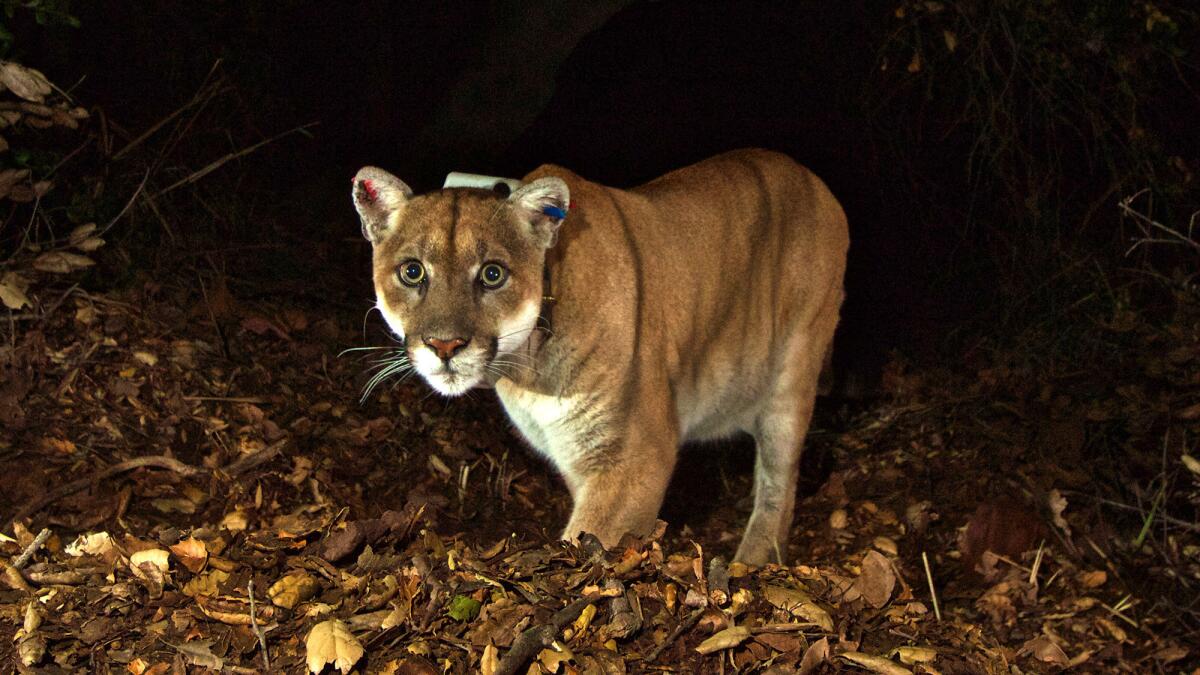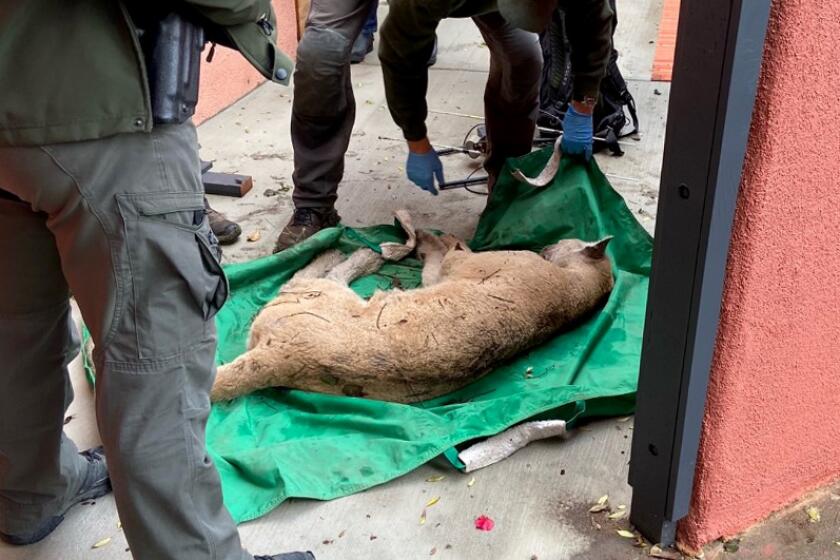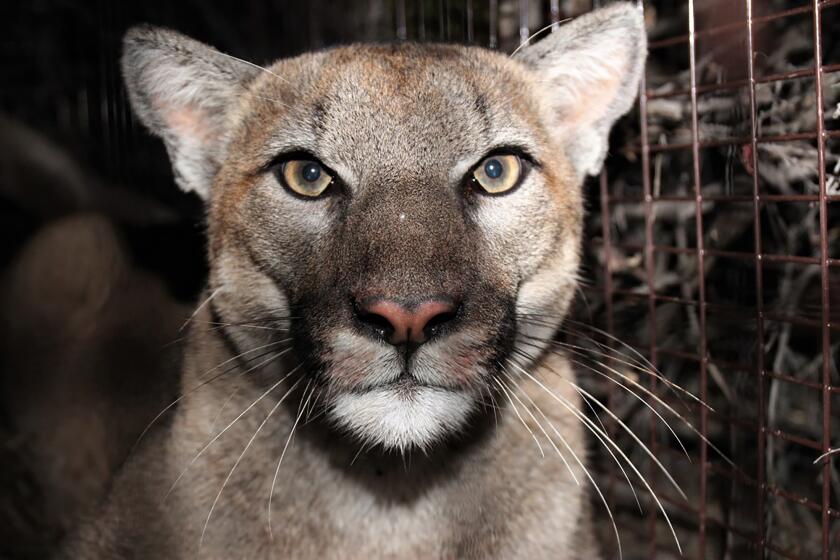P-22’s health seriously deteriorating, with euthanasia or sanctuary possible

- Share via
P-22, Los Angeles’ legendary mountain lion, is suffering from serious health issues and will not be released back into Griffith Park, according to officials, who said euthanasia is one option if his health deteriorates.
When the big cat was hauled out of a Los Feliz backyard Monday, wildlife officials planned to give him a thorough examination in order to assess what may have led him to wander into residential areas recently and attack small pets.
The California Department of Fish and Wildlife said no options are off the table when it comes to determining what might come next for the cat, who in November killed a leashed Chihuahua in the Hollywood Hills and attacked another Chihuahua in Silver Lake.
Now biologists say P-22 won’t be going back home to Griffith Park, where he has resided for more than a decade.
“At the moment, it’s not likely that P-22 will be released back into the wild based on [his condition] and the other health issues that he seems to be facing,” Ed Pert, a regional manager of the California Department of Fish and Wildlife, said at a news conference Tuesday.
The big cat had been sought for evaluation by the National Park Service and the California Department of Fish and Wildlife after “exhibiting some signs of distress.”
Wildlife officials decided to capture the 12-year-old mountain lion after his behavior became erratic.
Long wary of busy areas, P-22 had started to venture farther south into Silver Lake and other neighborhoods and stay for increasing periods of time. Already known as a killer, P-22 was increasing his nighttime prowling.
Veterinarian Winston Vickers from the UC Davis Wildlife Health Center said he has observed mountain lions change their behavior as they age and suffer from issues ranging from tooth problems to difficulties in tackling their normal prey.
“I don’t know if you’ve ever seen any video of a mountain lion attacking a deer, but it is a rigorous experience for everyone, including the mountain lion,” Vickers said. “I mean, they have all the aches and pains and arthritis and things that we have ... [and] it can get more and more difficult to achieve their normal prey capture.”
P-22 recovered well after being tranquilized Monday and removed from a Los Feliz yard, wildlife officials said. He was given fluids, vitamins and antibiotics and was resting comfortably at a veterinarian’s office.
But initial exams showed that the cat was in poor shape; he is significantly underweight, and his fur is thinning, officials said.
“Video evidence we received ... was showing this thinning of hair, potential muscle loss from his old age likely, also potential mange,” Jeff Sikich, a biologist with the National Parks Service, said Tuesday.
P-22 also has an injury to the right eye, likely the result of recent vehicular trauma, officials said.
Angelenos can’t help but see themselves in P-22. He’s carved out a life in a crowded city. And though he’s still handsome for his advanced age, he’s terminally single.
“Sometimes when people or animals are hit by cars, that trauma will take a while to manifest,” said Deanna Clifford, a senior veterinarian with the California Department of Fish and Wildlife. “So an eye injury always makes us a little worried about additional head trauma that we’re not quite sure of yet.”
P-22 will undergo more tests, officials said, including a CT scan to check for additional injuries and conditions. Those tests will help determine what comes next for the celebrated cat.
Mountain lions do not typically do well when relocated outside of their established territory, in part because they come into conflict with other lions, Pert said. With those considerations, the options for P-22 seem to be either a sanctuary or euthanasia if his health assessment “comes back very poor,” he said.
Each option has drawbacks.
“Unfortunately, wild adult mountain lions don’t do very well in captivity, typically,” Pert said. “There will have to be an evaluation of how P-22 behaves under those types of conditions.”
Should tests show that the cat’s health is severe, euthanasia would be “the most humane outcome,” he said. “We’re just trying to do what’s best for P-22, and that’s often a difficult call, just like when you’re dealing with a pet.”
The mysterious big cats fascinate and sometimes frighten us, especially when they become part of urban life. But they are wild and can be dangerous.
P-22 had previously survived mange after eating an animal that had ingested rat poison. The big cat showed up on trail-camera footage looking gaunt, his tail as thin as a pipe cleaner. Biologists trapped him, treated him with topical medications and vitamin K injections and released him.
At the time, only two other cougars studied by the federal government had contracted mange, and both died. But P-22 made a full recovery.
Sarah Picchi, who owns the home where P-22 was captured Monday, said she is hopeful his story has a happy ending.
“My husband and I hope P-22 is safe,” Picchi said. “Like the rest of L.A., we’re just rooting for him.”
But the fate of the city’s favorite mountain lion will rest in the hands of a team from the National Park Service and Fish and Wildlife, as well as outside veterinarians, Pert said. Everyone will be able to weigh in, he said.
Jordan Traverso, a spokesperson for Fish and Wildlife, said biologists are hoping for the best.
“Everybody understands the importance of this animal to the community and to California,” Traverso said. “And so, if [euthanasia is] the kind of decision that has to be made ... it’s not something that’s taken lightly.”
Times staff writer Laura J. Nelson and Gregory Yee contributed to this report.
More to Read
Sign up for Essential California
The most important California stories and recommendations in your inbox every morning.
You may occasionally receive promotional content from the Los Angeles Times.















